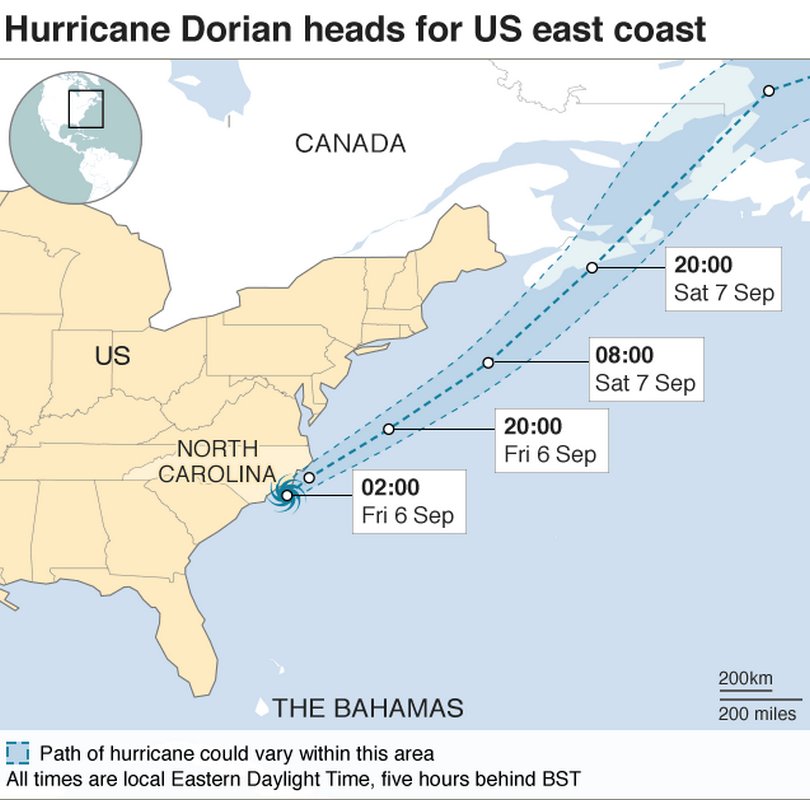The death toll from Hurricane Dorian in the Bahamas will be “staggering”, the country’s government has warned as aid efforts are being stepped up.
The official death toll stands at 30 but is expected to rise further.
Officials are sending morticians and 200 body bags to the Abaco Islands, the worst-hit part of the archipelago.
Dorian – which devastated the northern Bahamas from Sunday to Tuesday – has now made landfall in the US state of North Carolina, but is weakening.
Officials say hundreds, possibly thousands, are still missing in the Abacos and Grand Bahama.
On Thursday Health Minister Duane Sands warned of a “staggering” final count.
“The public needs to prepare for unimaginable information about the death toll and the human suffering,” he told local radio.
Dorian hit the Bahamas as a category five hurricane with winds reaching 185mph (297km/h).
It matched the highest ever recorded at landfall and stayed over affected areas for two days.
What is the damage to the Bahamas?
The International Red Cross fears 45% of homes on Grand Bahama and the Abacos – some 13,000 properties – were severely damaged or destroyed.
Parts of the Bahamas received up to 35in (89cm) of rain, leaving vast areas of it flooded.
The Island of Great Abaco is virtually uninhabitable, with bodies piled up, no water, power or food, and militias formed to prevent looting, local media report.
Aerial images over the Abacos showed mile upon mile of destruction, with roofs torn off, scattered debris, overturned cars, shipping containers and boats, and high water levels.
The only international airport in Grand Bahama was also devastated. As a result, it could not be used for evacuations or aid deliveries.
Floodwaters have reportedly rendered the Grand Bahamas’ main hospital unusable, according to the Associated Press news agency.
Several patients have been airlifted from Marsh Harbour Medical Centre in the Abacos, but the site is still being run as a shelter.
What is the latest on the aid effort?
The Bahamas’ government has signed an emergency declaration giving tax exemptions to medicine, building supplies and other goods that can be used for relief efforts.
International aid operations have been primarily focused on Grand Bahama and the Abacos, which were hit worst.
Search-and-rescue teams have been combing the worst-hit communities looking for any trace of survivors and bodies. As of Thursday, the US Coast Guard said it had rescued 201 residents.
Meanwhile, efforts to deliver aid are being ramped up. Planes and helicopters have been flying in emergency supplies to help the estimated 76,000 people in need of food and shelter.
Eight tonnes (8,000kg) of ready-to-eat meals, storage units, generators, and other emergency suppliers are to be flown in from Panama, the UN World Food Programme said.
A $5.4m (£4.3m) budget has been allocated to the UN agency for a three-month emergency operation in the Bahamas.
However, the International Federation of Red Cross and Red Crescent Societies said damage to roads and other infrastructure was hampering relief efforts.

Where is Dorian now?
Now downgraded to a category 1 hurricane, Dorian has made landfall in the US.
The US National Hurricane Center (NHC) said that at 09:00 local time (13:00 GMT) Dorian hit Cape Hatteras, North Carolina with 90mph (145km/h) winds.
The storm has already caused severe flooding and widespread power failures in Georgia, South Carolina, and North Carolina.
In the Carolinas, more than 900,000 people were ordered to evacuate their homes, but it was unclear how many had complied.
Forecasters said 10 inches (25 cm) of rain has fallen between the coasts of Charleston, South Carolina and Wilmington, North Carolina 170 miles away.
Dorian is expected to push north and out into the Atlantic but will make landfall again on Saturday in Canada’s island territory of Nova Scotia.
 Alghadeer TV Alghadeer TV
Alghadeer TV Alghadeer TV
